Early Christian Church - An Overview
Mike Ervin
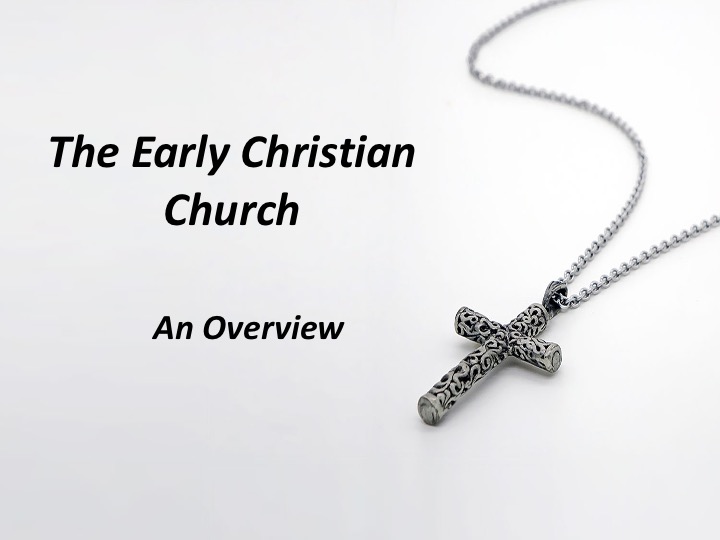
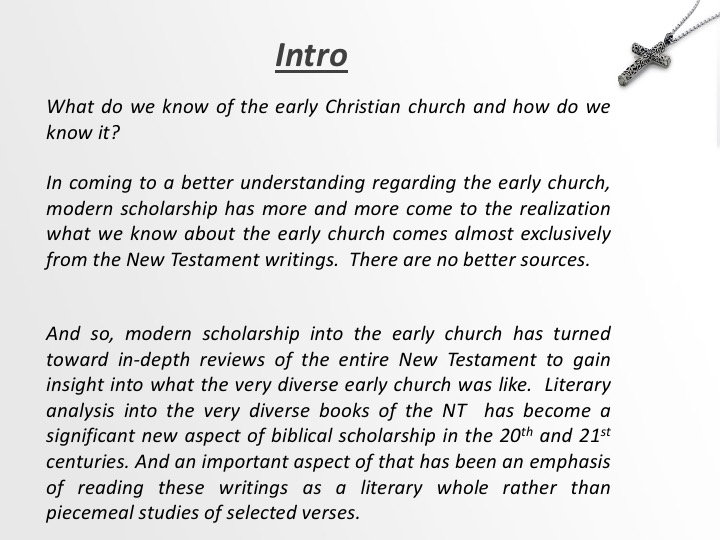
Intro
What do we know of the early Christian church and how do we know it?
In coming to a better understanding regarding the early church, modern scholarship has more and more come to the realization what we know about the early church comes almost exclusively from the New Testament writings. There are no better sources.
And so, modern scholarship into the early church has turned toward in-depth reviews of the entire New Testament to gain insight into what the very diverse early church was like. Literary analysis into the very diverse books of the NT has become a significant new aspect of biblical scholarship in the 20th and 21st centuries. And an important aspect of that has been an emphasis of reading these writings as a literary whole rather than piecemeal studies of selected verses.
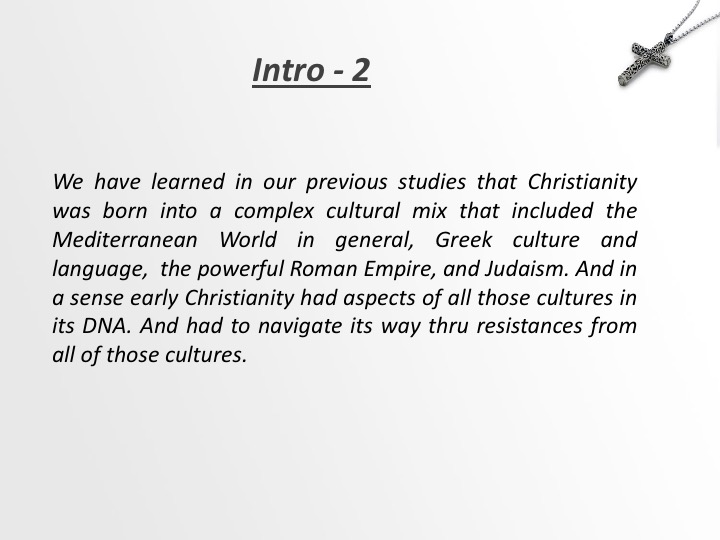
Intro-2
We have learned in our previous studies that Christianity was born into a complex cultural mix that included the Mediterranean World in general, Greek culture and language, the powerful Roman Empire, and Judaism. And in a sense early Christianity had aspects of all those cultures in its DNA. And had to navigate its way thru resistances from all of those cultures.
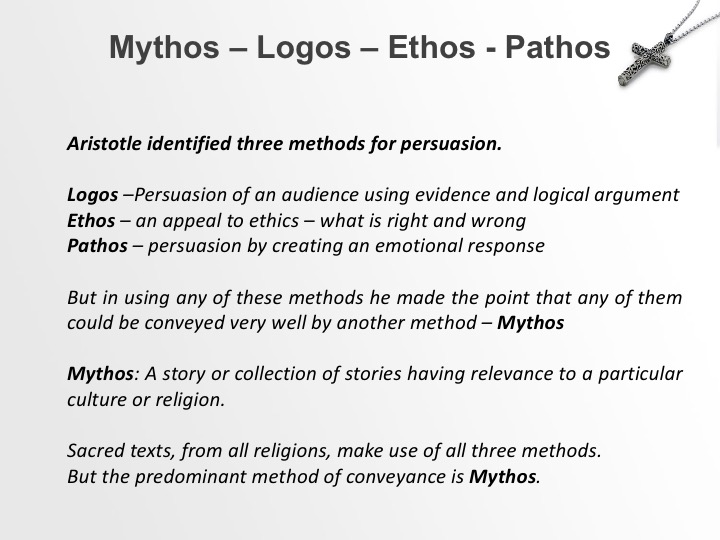
Mythos – Logos – Ethos - Pathos
Aristotle identified three methods that he called “ingredients for persuasion”
Logos – the logic behind arguments. Persuasion of an audience using evidence and logical arguments.
Ethos – an appeal to ethics – what is right and wrong.
Pathos – an appeal to emotion – persuading an audience by creating an emotional response.
But in using any of these methods he made the point that any of them could be conveyed very well by another method – Mythos
Mythos: A story or collection of stories having particular relevance to a particular culture or religion.
And modern scholarship on world religions has concluded that all sacred texts, from all religions, make use of all three of Aristotles’s methods. But the predominant method of conveyance is Mythos.
And separately From Aristotle, Plato argued that because Mythos speaks primarily to the soul, it is the preferred method for religious language.
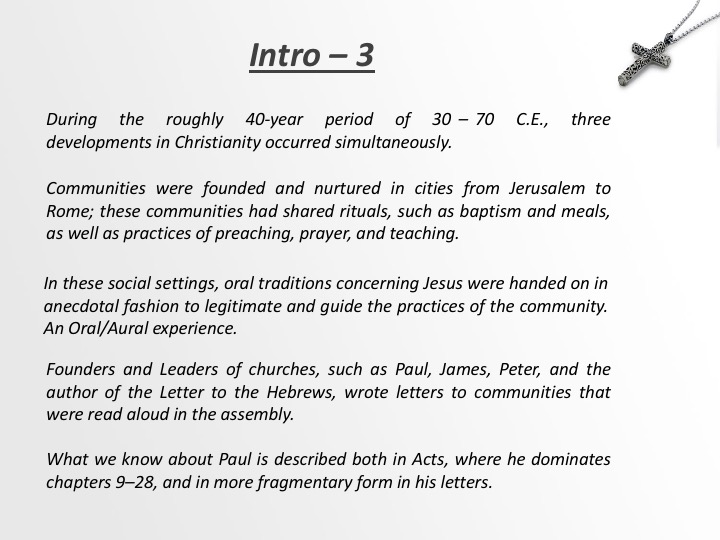
Intro - 3
During the roughly 40-year period of 30–70 C.E., three developments in Christianity occurred simultaneously.
Communities (churches = ekklesiai) were founded and nurtured in cities from Jerusalem to Rome; these communities had shared rituals, such as baptism and meals, as well as practices of preaching, prayer, and teaching.
In such social settings, oral traditions concerning Jesus were handed on in anecdotal fashion to legitimate and guide the practices of the community.
And it is important to note that the only stories about Jesus available were from these oral exchanges - In the period we are talking about - the four Gospels that we know had not yet appeared.
Leaders of churches, such as Paul, James, and the author of the Letter to the Hebrews, wrote letters to communities that were read aloud in the assembly.
Paul’s life is sketched both in Acts, where he dominates chapters 9–28, and in more fragmentary form in his letters.
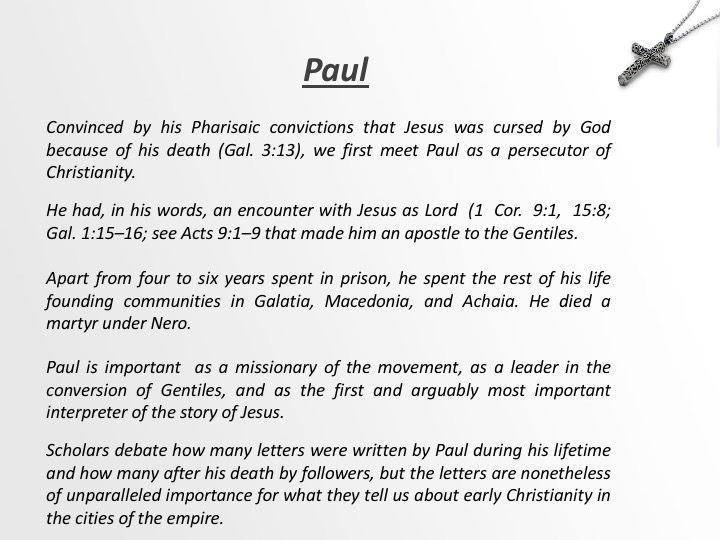
Paul
Convinced by his Pharisaic convictions that Jesus was cursed by God because of his death (Gal. 3:13), Paul sought to extirpate the movement.
He had, in his words, an encounter with Jesus as Lord (1 Cor. 9:1, 15:8; Gal. 1:15–16; see Acts 9:1–9) that made him an apostle to the Gentiles.
Apart from four to six years spent in prison, he spent the rest of his life founding communities in Galatia, Macedonia, and Achaia. He died a martyr under Nero.
Paul is important as a missionary of the movement, as a leader in the conversion of Gentiles, and as the first and arguably most important interpreter of the story of Jesus.
Scholars debate how many letters were written by Paul during his lifetime and how many after his death by followers, but the letters are nonetheless of unparalleled importance for what they tell us about early Christianity in the cities of the empire.
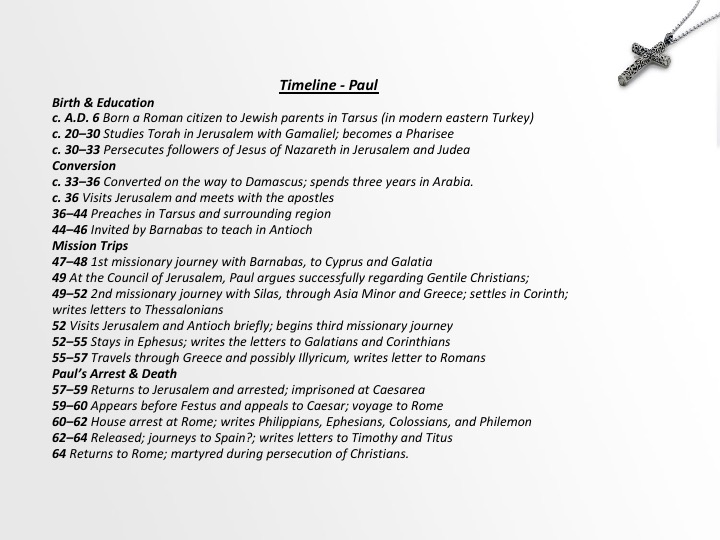
Timeline - Paul
Birth & Education
c. A.D. 6 Born a Roman citizen to Jewish parents in Tarsus (in modern eastern Turkey)
c. 20–30 Studies Torah in Jerusalem with Gamaliel; becomes a Pharisee
c. 30–33 Persecutes followers of Jesus of Nazareth in Jerusalem and Judea
Conversion
c. 33–36 Converted on the way to Damascus; spends three years in Arabia.
c. 36 Visits Jerusalem and meets with the apostles
36–44 Preaches in Tarsus and surrounding region
44–46 Invited by Barnabas to teach in Antioch
Mission Trips
47–48 1st missionary journey with Barnabas, to Cyprus and Galatia
49 At the Council of Jerusalem, Paul argues successfully regarding Gentile Christians;
49–52 2nd missionary journey with Silas, through Asia Minor and Greece; settles in Corinth; writes letters to Thessalonians
52 Visits Jerusalem and Antioch briefly; begins third missionary journey
52–55 Stays in Ephesus; writes the letters to Galatians and Corinthians
55–57 Travels through Greece and possibly Illyricum, writes letter to Romans
Paul’s Arrest & Death
57–59 Returns to Jerusalem and arrested; imprisoned at Caesarea
59–60 Appears before Festus and appeals to Caesar; voyage to Rome
60–62 House arrest at Rome; writes Philippians, Ephesians, Colossians, and Philemon
62–64 Released; journeys to Spain?; writes letters to Timothy and Titus
64 Returns to Rome; martyred during persecution of Christians.
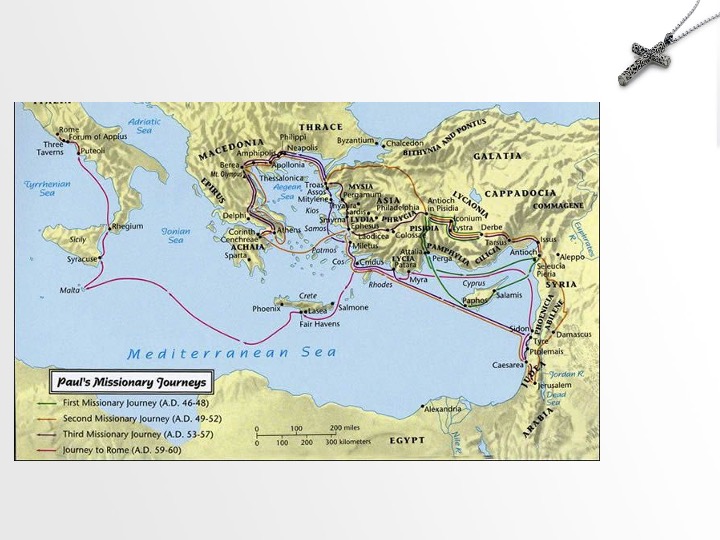
Paul’s Missionary Journeys
A map for your studying, we will not spend much time on this in class, but it will be available on our website.
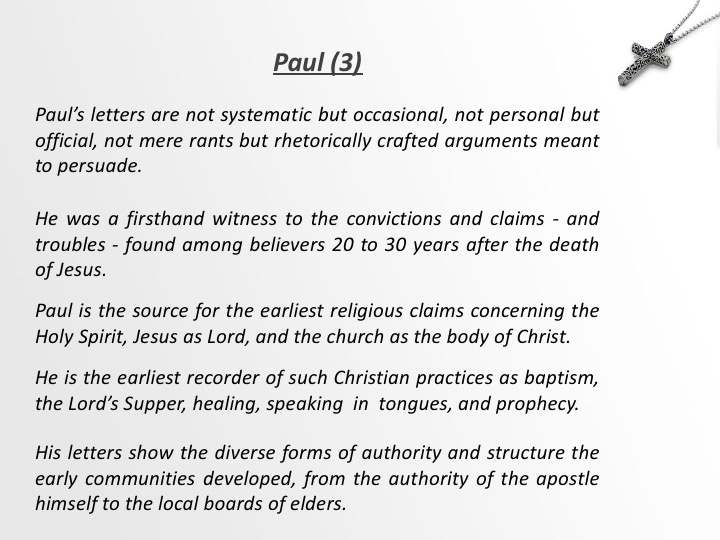
Paul - 3
Paul’s letters are not systematic but occasional, not personal but official, not mere rants but rhetorically crafted arguments meant to persuade.
He was a firsthand witness to the convictions and claims—and troubles—found among believers 20 to 30 years after the death of Jesus.
Paul is the source for the earliest religious claims concerning the Holy Spirit, Jesus as Lord, and the church as the body of Christ.
He is the earliest recorder of such Christian practices as baptism, the Lord’s Supper, healing, speaking in tongues, and prophecy.
His letters show the diverse forms of authority and structure the early communities developed, from the authority of the apostle himself to the local boards of elders.
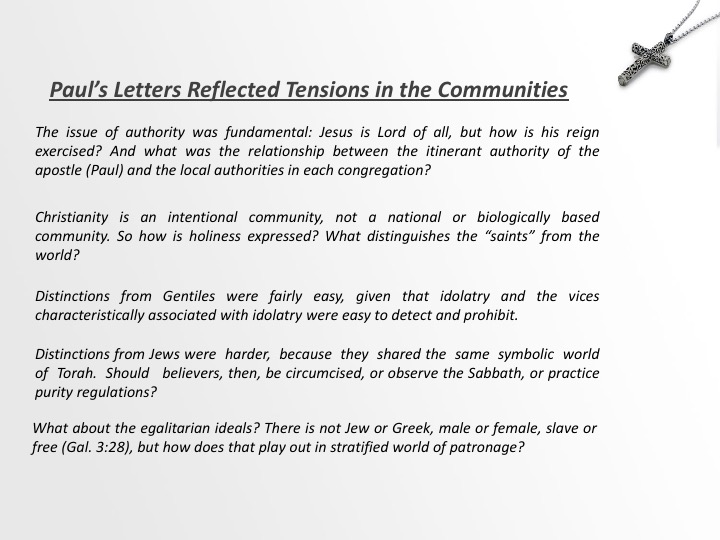
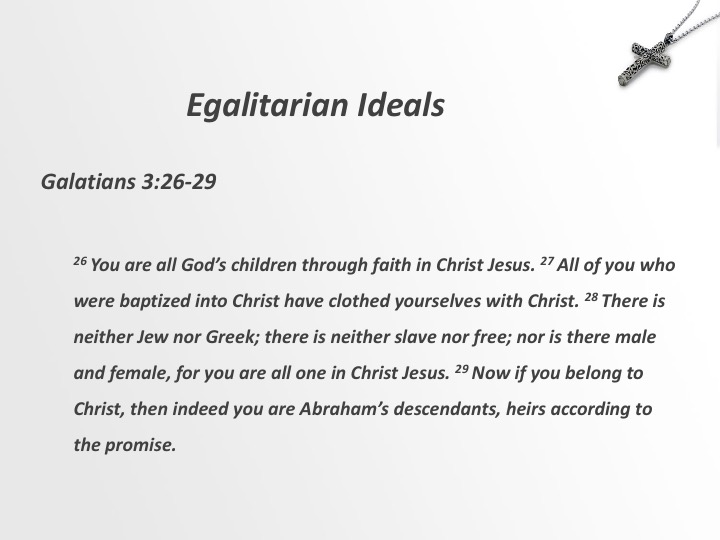
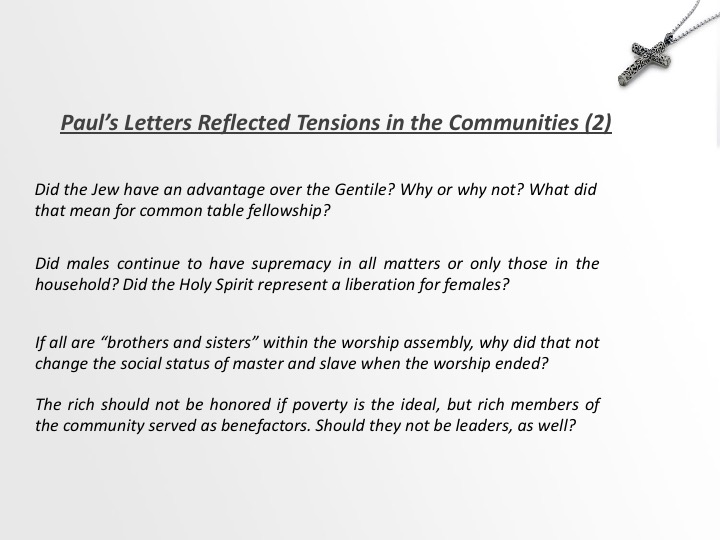
Paul’s Letters Reflected Tensions in the Communities (2)
Did the Jew have an advantage over the Gentile? Why or why not? What did that mean for common table fellowship?
Did males continue to have supremacy in all matters or only those in the household? Did the Holy Spirit represent a liberation for females?
If all are “brothers and sisters” within the worship assembly, why did that not change the social status of master and slave when the worship ended?
The rich should not be honored if poverty is the ideal, but rich members of the community served as benefactors. Should they not be leaders, as well?
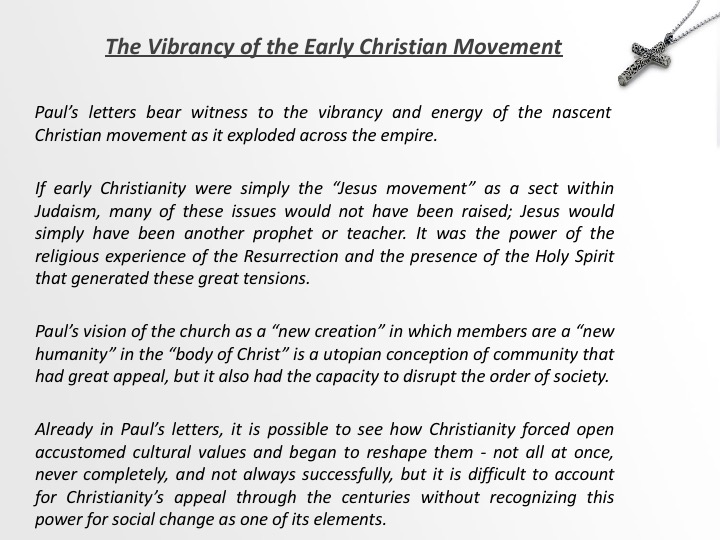
The Vibrancy of the Early Christian Movement
Paul’s letters also bear witness to the vibrancy and energy of the nascent Christian movement as it exploded across the empire.
If early Christianity were simply the “Jesus movement” as a sect within Judaism, many of these issues would not have been raised; Jesus would simply have been another prophet or teacher. It was the power of the religious experience of the Resurrection that generated these great tensions.
Paul’s vision of the church as a “new creation” in which members are a “new humanity” in the “body of Christ” is a utopian conception of community that had great appeal, but it also had the capacity to disrupt the order of society.
Already in Paul’s letters, it is possible to see how Christianity forced open accustomed cultural values and began to reshape them—not all at once, never completely, and not always successfully, but it is difficult to account for Christianity’s appeal through the centuries without recognizing this power for social change as one of its elements.
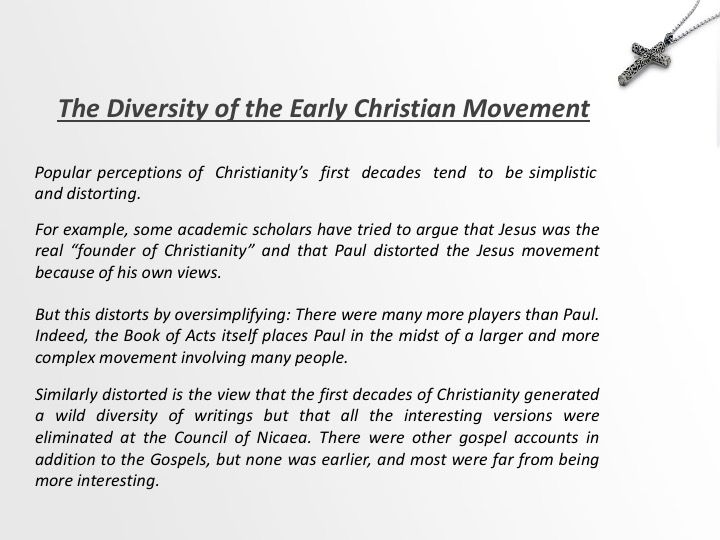
The Diversity of the Early Christian Movement
Popular perceptions of Christianity’s first decades tend to be simplistic and distorting.
For example, some academic scholars have tried to argue that Jesus was the real “founder of Christianity” and that Paul distorted the Jesus movement because of his own views.
But this distorts by oversimplifying: There were many more players than just these two. Indeed, the Book of Acts itself places Paul in the midst of a larger and more complex movement involving many people.
Similarly distorted is the view that the first decades of Christianity generated a wild diversity of writings but that all the interesting versions were eliminated at the Council of Nicaea. There were other gospel accounts in addition Gospels, but none was earlier, and most were far from being more interesting.
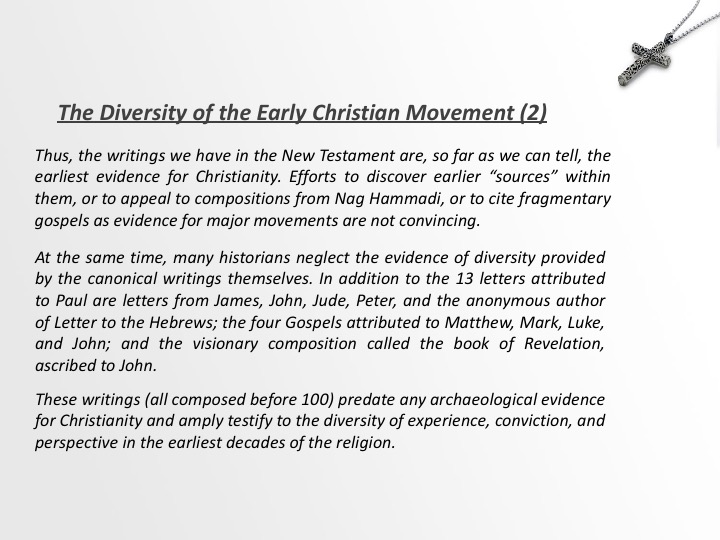
The Diversity of the Early Christian Movement (2)
Thus, the writings we have in the New Testament are, so far as we can tell, the earliest evidence for Christianity. Efforts to discover earlier “sources” within them, or to appeal to compositions from Nag Hammadi, or to cite fragmentary gospels as evidence for major movements are not convincing.
At the same time, many historians neglect the evidence of diversity provided by the canonical writings themselves. In addition to the 13 letters attributed to Paul are letters from James, John, Jude, Peter, and the anonymous author of Letter to the Hebrews; the four Gospels attributed to Matthew, Mark, Luke, and John; and the visionary composition called the book of Revelation, ascribed to John the Seer.
These writings (all composed before 100) predate any archaeological evidence for Christianity and amply testify to the diversity of experience, conviction, and perspective in the earliest decades of the religion.
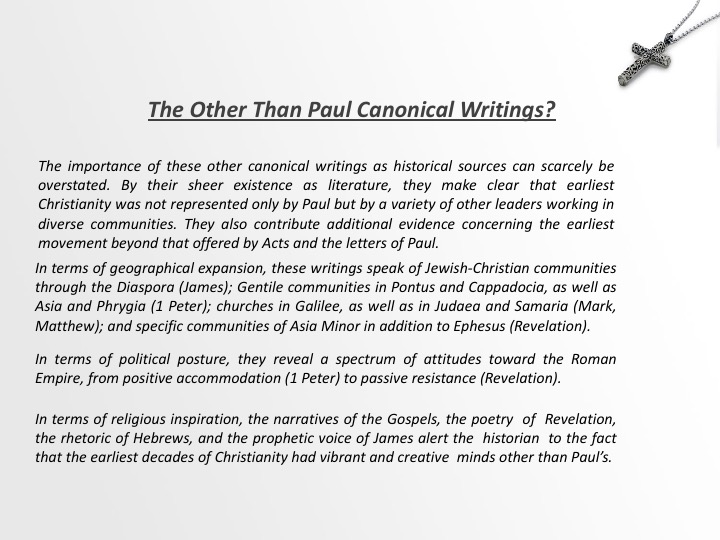
The Other Than Paul Canonical Writings?
The importance of these other canonical writings, simply as historical sources, can scarcely be overstated. By their sheer existence as literature, they make clear that earliest Christianity was not represented only by Paul but by a variety of other leaders working in diverse communities. They also contribute additional evidence concerning the earliest movement beyond that offered by Acts and the letters of Paul.
In terms of geographical expansion, these writings speak of Jewish-Christian communities through the Diaspora (James); Gentile communities in Pontus and Cappadocia, as well as Asia and Phrygia (1 Peter); churches in Galilee, as well as in Judaea and Samaria (Mark, Matthew); and specific communities of Asia Minor in addition to Ephesus (Revelation).
In terms of political posture, they reveal a spectrum of attitudes toward the Roman Empire, from positive accommodation (1 Peter) to passive resistance (Revelation).
In terms of religious inspiration, the narratives of the Gospels, the poetry of Revelation, the rhetoric of Hebrews, and the prophetic voice of James alert the historian to the fact that the earliest decades of Christianity had vibrant and creative minds other than Paul’s.
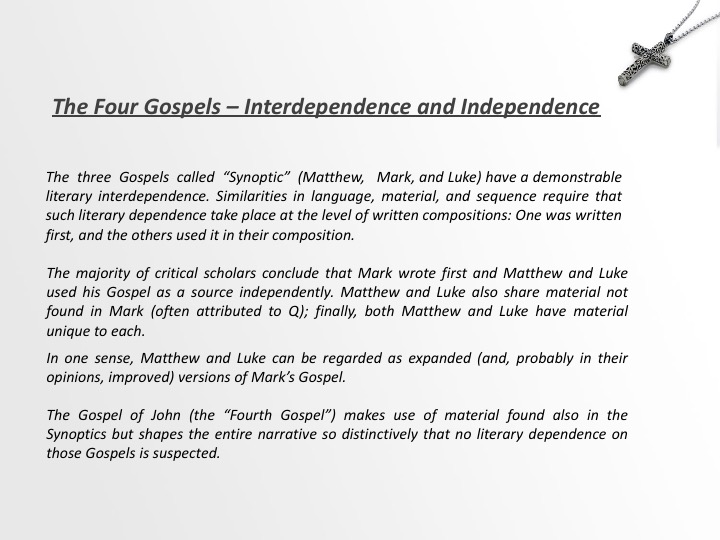
The Four Gospels – Interdependence and Independence
The three Gospels called “Synoptic” (Matthew, Mark, and Luke) have a demonstrable literary interdependence. Similarities in language, material, and sequence require that such literary dependence take place at the level of written compositions: One was written first, and the others used it in their composition.
The majority of critical scholars conclude that Mark wrote first and Matthew and Luke used his Gospel as a source independently. Matthew and Luke also share material not found in Mark (often attributed to Q); finally, both Matthew and Luke have material unique to each.
In one sense, Matthew and Luke can be regarded as expanded (and, by their light, improved) versions of Mark’s Gospel.
The Gospel of John (the “Fourth Gospel”) makes use of material found also in the Synoptics but shapes the entire narrative so distinctively that no literary dependence on those Gospels is suspected.
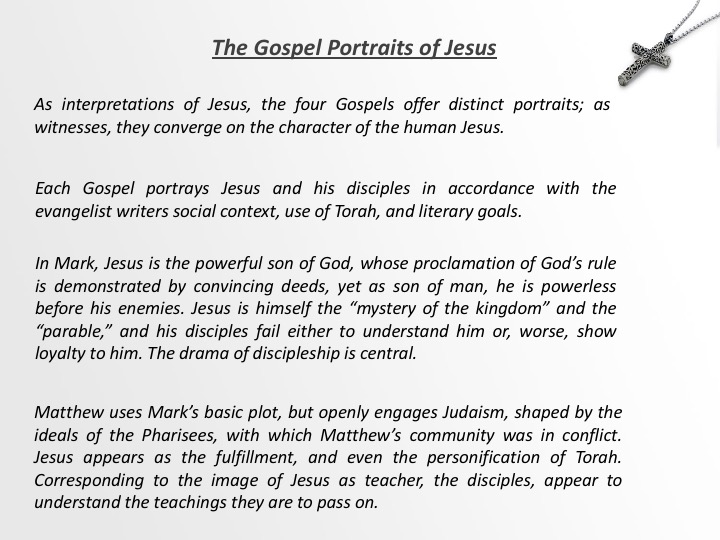
The Gospel Portraits of Jesus
As interpretations of Jesus, the four Gospels offer distinct portraits; as witnesses, they converge on the character of the human Jesus.
Each Gospel portrays Jesus and his disciples in accordance with the evangelist’s social context, use of Torah, and literary goals.
In Mark, Jesus is the powerful son of God, whose proclamation of God’s rule is demonstrated by convincing deeds, yet as son of man, he is powerless before his enemies. Jesus is himself the “mystery of the kingdom” and the “parable,” and his disciples fail either to understand him or, worse, show loyalty to him. The drama of discipleship is central.
Matthew uses Mark’s basic plot and opens it to a conversation with formative Judaism—shaped by the ideals of the Pharisees and the techniques of the scribes—with which Matthew’s community was in conflict. Jesus appears as the fulfillment, the teacher, and indeed, the personification of Torah. Corresponding to the image of Jesus as teacher, the disciples, though no less faithless than those in Mark, understand the teachings they are to pass on.
Luke also uses Mark but extends his story to another complete volume (the Acts of the Apostles). Jesus is God’s prophet who reverses societal norms, heals, and associates with the marginal. In the sequel, his disciples live out his ideal as his successor-prophets.
John portrays Jesus as the man from heaven who, as the light, intersects the darkness of the world and calls it to conversion. His disciples are to continue his witness to the truth of God and will experience the same hatred from the world as Jesus did.
Despite such divergence in interpretation, the four Gospels converge in their understanding of the character of Jesus and of discipleship. They agree that Jesus is defined by an absolute obedience to God rather than by career, popularity, possessions, pleasure, or power: “not my will but your will be done.”
They agree further that this radical obedience is expressed through dispositions of self-giving to others: He “gives his life for others” and is “the servant of others.”
They agree that discipleship is a matter of “following” Jesus and exhibiting the same character of radical obedience and self-emptying love.
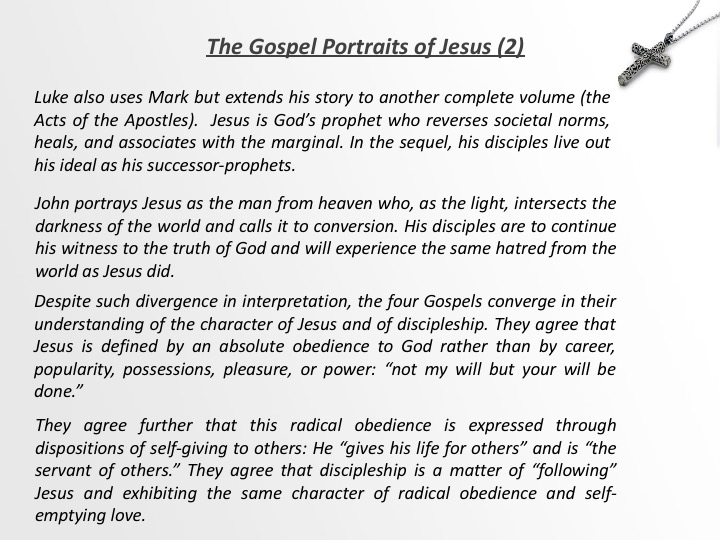
The Gospel Portraits of Jesus (2)
Luke also uses Mark but extends his story to another complete volume (the Acts of the Apostles). Jesus is God’s prophet who reverses societal norms, heals, and associates with the marginal. In the sequel, his disciples live out his ideal as his successor-prophets.
John portrays Jesus as the man from heaven who, as the light, intersects the darkness of the world and calls it to conversion. His disciples are to continue his witness to the truth of God and will experience the same hatred from the world as Jesus did.
Despite such divergence in interpretation, the four Gospels converge in their understanding of the character of Jesus and of discipleship. They agree that Jesus is defined by an absolute obedience to God rather than by career, popularity, possessions, pleasure, or power: “not my will but your will be done.”
They agree further that this radical obedience is expressed through dispositions of self-giving to others: He “gives his life for others” and is “the servant of others.” They agree that discipleship is a matter of “following” Jesus and exhibiting the same character of radical obedience and self-emptying love.
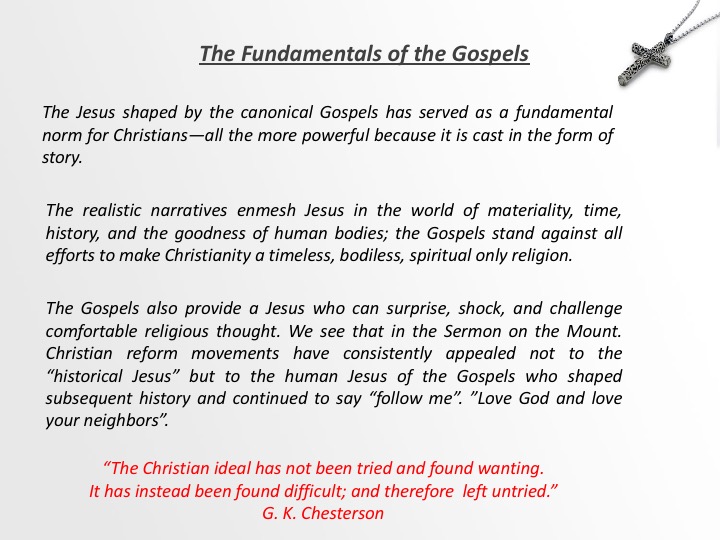
The Fundamentals of the Gospels
The Jesus shaped by the canonical Gospels has served as a fundamental norm for subsequent Christians—all the more powerful because it is cast in the form of story.
The realistic narratives enmesh Jesus in the world of materiality, time, history, and the goodness of human bodies; the Gospels stand against all efforts to make Christianity a timeless, bodiless, anti- institutional religion.
The Gospels also provide a Jesus who can surprise, shock, and challenge comfortable religious accommodation. We see that in the Sermon on the Mount. Christian reform movements have consistently appealed not to the “historical Jesus” but to the human Jesus of the Gospels who shaped subsequent history and continued to say “follow me”. ”Love God and love your neighbors”.
Every time I read the Sermon on the Mount I am reminded of the famous quote by G. K. Chesterson, the Catholic writer.
“The Christian ideal has not been tried and found wanting. It has been found difficult; and left untried.”
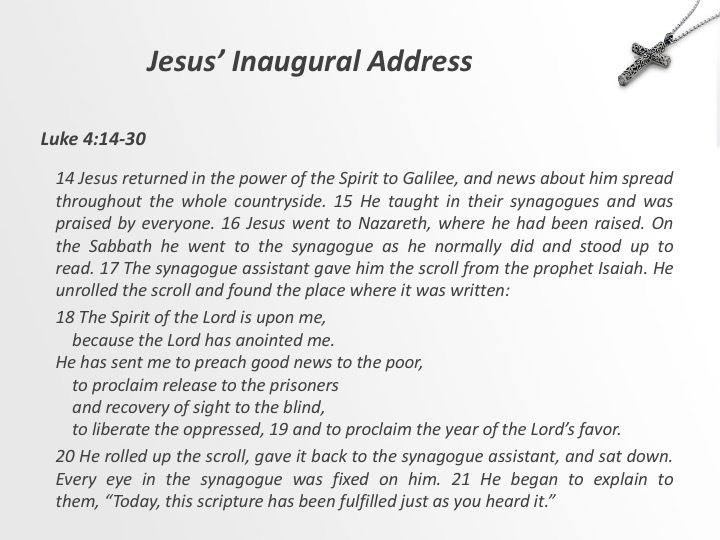
Jesus’ Inaugural Address
Several modern scholars have referred the scripture as Jesus' Inaugural Address". Chapter 4 verse 1 of Luke begins describing Jesus emerging from his baptism and experiencing the Spirt of God, then going to the desert for 40 days and successfully grappling with Satan. Then we see verse 14.
Luke 4:14-30
14 Jesus returned in the power of the Spirit to Galilee, and news about him spread throughout the whole countryside. 15 He taught in their synagogues and was praised by everyone. 16 Jesus went to Nazareth, where he had been raised. On the Sabbath he went to the synagogue as he normally did and stood up to read. 17 The synagogue assistant gave him the scroll from the prophet Isaiah. He unrolled the scroll and found the place where it was written:
18 The
Spirit of the Lord is upon me,
because the Lord has anointed me.
He has sent me to preach good news to the
poor,
to proclaim release to the prisoners
and recovery of sight to the
blind,
to liberate the oppressed, 19 and to proclaim
the year of the Lord’s favor.
20 He rolled up the scroll, gave it back to the synagogue assistant, and sat down. Every eye in the synagogue was fixed on him. 21 He began to explain to them, “Today, this scripture has been fulfilled just as you heard it.”
This was Jesus announcing his mission.
